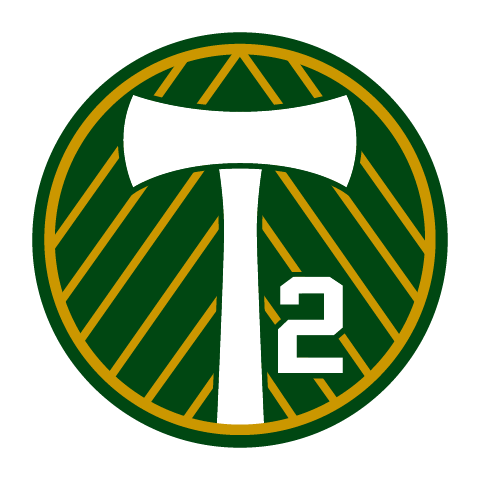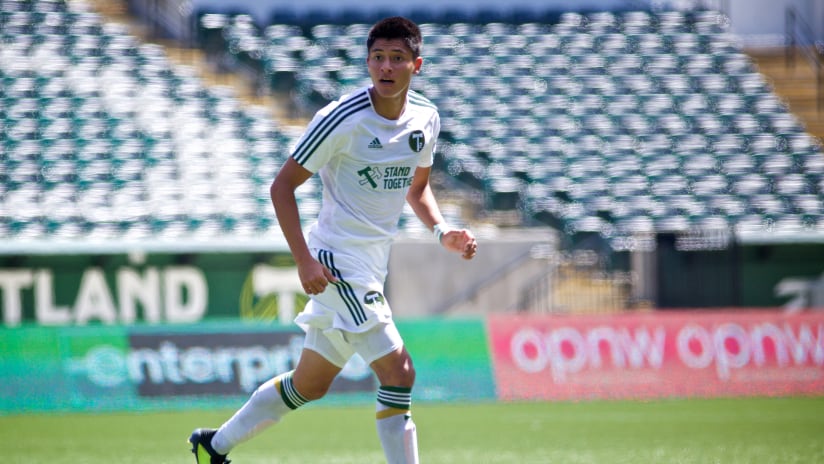BEAVERTON, Ore. – Giovanni Savarese had left the western field at the adidas Timbers Training Center, walked across the eight feet of pavement that separates the complex’s two fields, and began watching the Portland Timbers’ United Soccer League team, Timbers 2. A chest-high black fence separated a line of onlookers from head coach Cameron Knowles’ charge, whose session was transitioning from drills and small-sided games to tactical work. For Savarese, the August afternoon gave him a chance to check-in on the next level of his depth chart.
The team he runs on a day-to-day basis, the organization’s Major League Soccer team, had finished their day’s session, with his squad left to the team’s athletic trainers for final stretches. Normally, Savarese would spend this time supervising shooting drills, attending media responsibilities, or huddled among his staff in consideration of the day’s session. On this day, however, he was taking time to watch some of the players who might permanently occupy the western field in the future.
“Finish over here,” a voice asked, speaking over Savarese’s right shoulder, surprising a Timbers’ boss who’d become focused on the depth at T2. It was Marco Farfan, a fullback who has spent the season playing in both worlds. After training with one team, the Timbers Academy product was asking whether he should get in extra work with the other.
“Yes, the final 30 minutes,” Savarese answered, eagerly, looping his arm around Farfan’s shoulders to guide him toward the field. T2 would need Farfan the coming weekend, where a home game gave them another chance to correct their course. After a summer that had solidified a place in the USL Western Conference’s postseason picture, T2 was enduring a difficult moment, one that had temporarily taken them below the playoff line. Having players like Farfan serve more consistent roles helped correct the team’s course.
“With this latter part of the season,” Knowles explains, “we’ve had more consistency with the players we’ve been getting and the players we’ve been playing, which obviously helps. That familiarity is key.”
Particularly when the USL team plays in Portland, Farfan has been a regular at left back. All season, though, he’s trained eight feet away, with the MLS squad, leaving him a question and an affirmative response from transitioning between worlds.
“I’ve actually gotten more first-team minutes this year than last year, so that’s good progress,” Farfan, 19, says, when asked about splitting time between PTFC’s two squads. In 2017, Farfan got 404 minutes with the Timbers. In 2018, he is up to 423, and he has made four more MLS appearances than he did a year ago. “The good thing is that I’m actually getting time with T2, as well. There’s obviously a lot of talent on the first team, and trying to break into it is still the goal, every single time, every single training of them week.
“But if I won’t be starting with the first team or getting minutes, it’s good to get minutes with T2, as well. It’s good because it helps me as a player to develop and try to break into the first team, again.”
Farfan isn’t the only player who crosses that eight-foot divide on a regular basis. Central defender Modou Jadama has done the same if not more so, training with the Timbers while spending most of his matchdays with T2. Forwards Jeremy Ebobisse and Foster Langsdorf and goalkeeper Kendall McIntosh have occupied the same world, as has midfielder Jack Barmby, while first-team mainstays like winger Dairon Asprilla, defender Roy Miller and defender/midfielder Bill Tuiloma have been regularly called on to be part of the revitalization of T2.
That is, undeniably, what has happened over the last 12 months. When the Timbers’ USL team finished the 2017 season with only three wins, the organization had to answer a question: How was it going to utilize its USL franchise most successfully? The organization thought it was doing so ahead of the 2017 season – nobody ever plans on claiming 15 points in 32 games – but amid that performance was born a new set of priorities. That new set of priorities, one that intended on revitalizing the club’s second-division effort, has put much of the first team’s talent in T2’s purview.
Farfan has made 10 appearances this season for T2. Ebobisse has made 18. Jadama and Langsdorf, both on Major League Soccer contracts, have made 25 and 28 appearances, respectively, while a slew of other Timbers that would have previously been outside of T2’s orbit have spent time in USL: David Guzmán (one appearance); Julio Cascante (one); Asprilla (four); Lucas Melano (two); and Tomás Conechny (two).
T2 wasn’t a totally neglected corps last season. Players like Ben Zemanski, Amobi Okugo, Chance Myers and Zarek Valentin – players many would instinctively consider established, first-division professionals – played multiple games in USL last season. But the level of integration between first-division team and second- wasn’t the same. This year, managing the way players have to balance commitments has become a concerted part of the technical staffs’ preparation.
“It’s a lot of planning,” Savarese said. “We go through a lot of planning to make sure that [the players] are efficient when they go to T2, that they are still able to practice with [the first team], and keep a quality of practice … it’s that balance between the two teams, to make sure guys at T2 feel like they have an opportunity to come [to the first team] when they do well.”
Venezuelan midfielder Renzo Zambrano, most recently, enjoyed that opportunity, joining the Timbers for training after the MLS team’s weekend victory over Real Salt Lake. He’s been one of T2’s two most important players this season, as has winger Marvin Loría, who has also enjoyed multiple sessions with the first team. When injuries or absences have left the first team needing numbers, they’ve been there to step in. Midfielder Andre Lewis, fullback Jimmy Mulligan and defender Arturo Diz Pe have gotten turns on the west field, too, as have much of the USL team. Earning a day’s training with the first team has become part of T2’s course.
For some, though, the duality has taken time to get used to.
“It was pretty difficult in the beginning,” Jadama admits, “but as I got to playing more and more games with [T2], I got used to it. You don’t get to train with the same team every game, every day. It’s definitely different. But I got used to the style of play, and with (head coach) Cam (Knowles) and (assistant coach Andrew) Gregor, I did well, instilling what they want in the game.”
Despite being on an MLS contract, Jadama has become one of the leaders of T2. As has McIntosh, who is in his third season with the USL team. Farfan’s MLS quality has occasionally proved a game-changing presence on T2’s left flank, while Ebobisse, despite now establishing himself as a first-XI option for the MLS team, has also played a significant role in T2’s push.
“Part of me wants to help finish the story with them and see how far we can go,” Ebobisse admits, echoing a sentiment other first-team-contracted players have developed during T2’s season. “At the same time, I know I’m needed with the first team, right now. I just keep an eye on [T2] from afar, support all the guys. I’m as close with the T2 guys as I am the first team guys, so it’s cool to see them succeeding.”
T2 have 52 points, this year. They’ve won 16 times in 33 matches, and after Saturday’s game at Phoenix Rising FC, the team will enter the USL Playoffs for the first time since launching before the 2015 season. It will also be the first time T2 posts more wins than losses.
It’s the transformation the organization wanted, part of the reason so many players have spent 2018 as part of two teams, not one. Even in that dual role, though, the priorities have remained clear.
“No, it’s one club,” Farfan says, when asked about roles that leave him crossing the Training Center’s eight-foot path. “It’s has to be the same mentality in every single game … No matter where you play, no matter who you play with, the mentality always has to be the same.”
That mentality, and the commitment T2 has gotten from the Timbers’ first-team talents, have helped right the USL team’s course.




